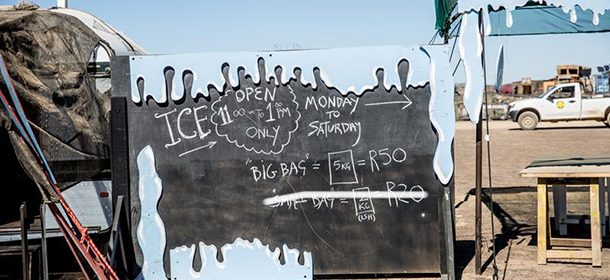BINNEKRING BLOG
The Ice Queen Speaks
Words: Abi Case / Photos: credits on shot
Hi. My name’s Abi. I’m the Ice Queen.
You might have met me in the Ice queue. However, I’m usually backstage conducting the heaving circus that is Die Yskas.
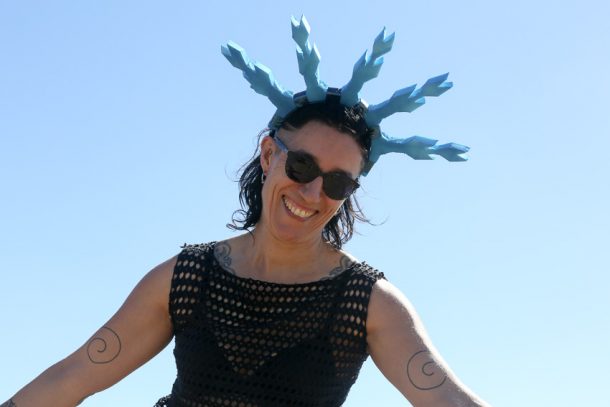
My crew and I have our work cut out for us taking orders, slinging ice and trying to reason with flustered faces, waving fistfuls of rands, under the mistaken impression that their default world bank balance means they can demand the kind of service they’re accustomed to. In Tankwa Town, of all places.
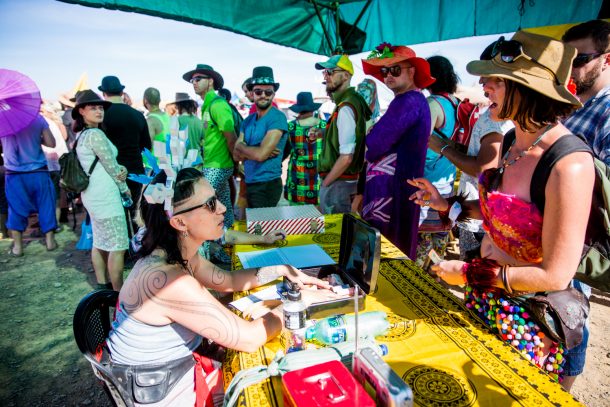
So, ice. In the desert. Think about it: it’s an anomaly, and a pretty tough promise to deliver on. To explain, here’s some info on how we run our ice, and why, in Tankwa Town.
Why don’t we just make the ice at the event?
This is an old question, and one that gets asked every year by a number of people. It works like this: the technology and water supply required to make the volumes of ice our village goes through is pretty demanding.
For a start, you can’t simply pump Tankwa groundwater or river water into an ice machine, because ice machines are very picky about the quality of water they’ll accept. For that matter, we’re pretty picky about the water quality too – because dodgy water in the ice would mean you could get ill, and that would be game over. (By the way, the ice didn’t cause the outbreak of GI complaints last year – because only purified water is used in our ice. If you’d like to know what did cause it, you can find out here).
So, it turns out that to make ice you have to use very pure water, and that means filtration. If you manage to overcome that obstacle, then there’s another ahead: where would you store your clean water? OK, so…bowsers? Jojo tanks? Solved that one?
Alright, your next challenge would be power. As it happens, ice machines (which are notoriously temperamental) use a shitload of electricity to convert H20 from liquid to solid. So if we were to produce the ice on site, we’d need an enormous amount of power. Generator? That would mean fuel, and crew to manage the genny and ice plant. Solar & deep cycle batteries? Same story: we’d still need the crew, as well as a big budget to acquire the equipment.
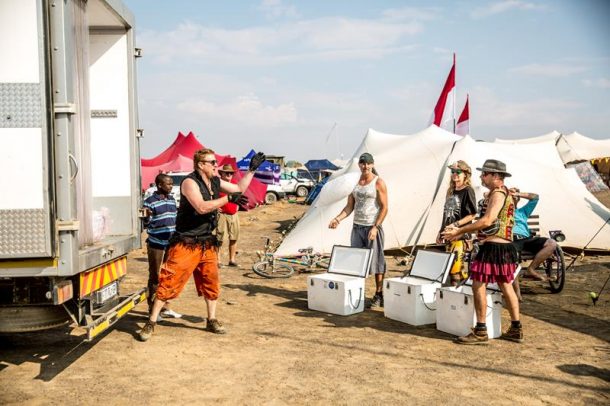
But let’s say we did manage to store pure water, and make ice in the desert. OK – but there’s another issue: refrigeration plants that can store ice also use up loads of power. So, add that to your theoretical Tankwa Ice Inc. plant needs, and you’re already looking at a pretty serious operation to make your elusive desert ice. And there’s another thing – wouldn’t you know? – the desert heat not only wreaks havoc with storing ice, but also with the machinery to make it, and keep it frozen. Essentially, you’d need to build a huge insulated warehouse, to make it happen. (Who of you remember The Mosquito Coast?!)
But wait! As if there weren’t already enough obstacles in the way of the Tankwa Ice Inc. dream, there’s even yet another: to make enough ice to supply our town for 6 days would take months. In 2017, our ice station served 32 tons of ice. For our theoretical Tankwa ice plant to make that would take… approximately 3.5 months (and a crew who’d need everything you need to stay alive in the desert for this long.)
If all of the above were possible to achieve, it would make the price of your 5kg bag of ice skyrocket, and would result in a very reasonable middle finger from everyone in the ice queue.
So, that’s the long & short of why we don’t make our own ice in the Tankwa.

Where does the ice come from, then?
It comes from a company that manufactures it in Worcester – and there are two reasons for that. Number 1, is because it’s the closest large-scale ice producer to the Tankwa Karoo. Number 2 is because Worcester has ample reliable water supply, on account of having 3 large dams in the surrounding mountains. Turns out, it’s a self-reliant town, even in a drought! The water is filtered by reverse osmosis at the ice factory, processed and then stored in advance of our event dates, in ginormous coldrooms. Then it’s dispatched by truck to our site, in 4-ton freezer trucks that run in rotation. As you well know, the R355 eats tyres for breakfast – and sometimes, it also eats our ice truck tyres. (By the way, did you know that it’s not possible for a truck driver to change his own tyre? He needs to call for the truck breakdown service to help him. On the longest road in the country with no cellphone reception…) Which explains why sometimes deliveries run late, resulting in less ice than some folks might like.
Why not just get more ice, and sell more?
One thing I have learnt in my 3 years as the Ice Queen, is that demand is really hard to predict. Despite looking back after every event at the daily trends, I’ve learnt that every year is different, with fresh challenges and there is no clear pattern.
The trucks cost a fair bit to rent, and to have an entire fleet on hand to dispatch, should the weather and demand call for it, would once again make for way more expensive ice. So, we are limited by the trucks we have on hand to bring as much as we can to site. And, once the ice has arrived in Tankwa Town, it can’t be returned if not used. This means we have to make very well-informed calls on how much to dispatch from our supplier – because anything left over becomes expensive water.
If I bring my own ice how should I store it, to make the most of it?
Start by bringing as much ice as you can, pick it up at your last possible stop, and store it in your best cooler box. Seal the cooler with duct tape until you arrive, and the ice should remain rock solid. Once settled in your camp, keep this cooler box off the ground, in your deepest shade and cover it with a blanket. Each morning, take out what you need for the day, put it in another cooler box and use that for your drinks. Tell your drunk friend to stay the hell out of the ice store, or else!
Think about freezing 2 litre plastic cool drink bottles of water at home, and bringing those as ice bricks to use in your food cooler box. Once it’s melted after keeping your food fresh, you can drink the cold water.
(if you’d like more tips on how to make the most of your ice and cooler boxes, check out Ranger Mushroom’s post, ‘Life Beyond The Fridge’)
What if I’ve got a big camp that gifts drinks with ice?
Please help us by not relying entirely on Die Yskas for your ice supply. You should consider hiring a trailer freezer unit, and packing that sucker as full as you can before leaving civilisation. This way, the ice queue won’t put a damper on your frozen Margaritas! Freezer trailers aren’t particularly expensive to rent, and if you have one, you’re going to be one very popular camp.
On this note, respect to Camps OasIce and Igloo, who plan to do the impossible and make ice in the desert as their gift to all of us!
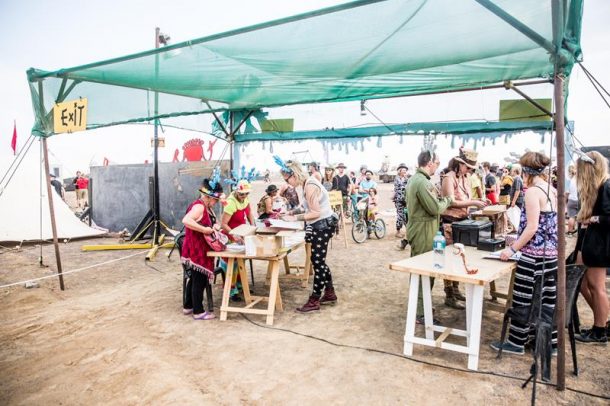
What is AfrikaBurn doing to improve on the 2017 ice queues?
We’ve learnt from last year’s challenges and have an improved plan in place to bring even more ice to the desert. We will have double the number of trucks working in rotation, with accommodation for the drivers in Worcester, which will allow the trucks to leave site as soon as they empty and return the next morning with fresh stock. Bear in mind that in the past the empty trucks had to wait until first light to leave site, and then do a 12 hour round trip to Worcester that same day!
We also have a huge 18×20 stretch tent into which we will snake as much of the queue as possible, to keep you all much happier and cooler whilst waiting. This time round, we’ll get your ice to you faster, as we’ve increased the crew size (and thus the volume of ice we can get to you). There are still some volunteer slots open, so sign up right here if you want to join the coolest crew on site.
We will only be selling 5kg bags, as the demand for the small bags has tapered off over the years. Despite the improved and more expensive logistics, we have managed to keep the price the same as last year – R50 per bag. Just like AfrikaBurn, the ice sales are not driven by profit: the purpose of selling ice is to keep us all healthy and cool in the desert, and we are only ever looking to cover our infrastructure and logistics costs.
My name is Abi, and I’m the Ice Queen – see you at Die Yskas!



